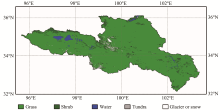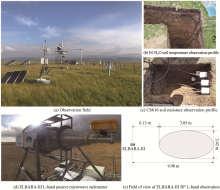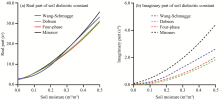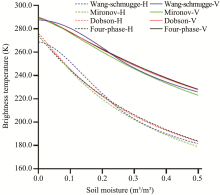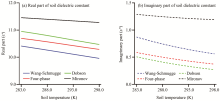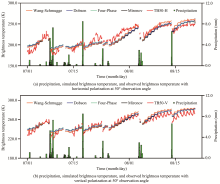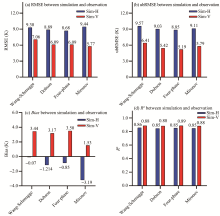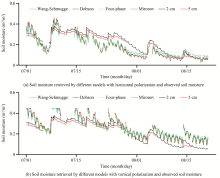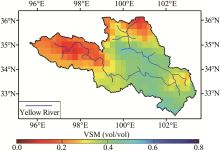Sciences in Cold and Arid Regions ›› 2021, Vol. 13 ›› Issue (1): 62–76.doi: 10.3724/SP.J.1226.2021.20067
• • 上一篇
Evaluating effects of Dielectric Models on the surface soil moisture retrieval in the Qinghai-Tibet Plateau
Rong Liu1( ),Xin Wang1,ZuoLiang Wang1,Jun Wen2
),Xin Wang1,ZuoLiang Wang1,Jun Wen2
- 1.Key Laboratory of Land Surface Process and Climate Change in Cold and Arid Regions, Northwest Institute of Eco-Environment and Resources, Chinese Academy of Sciences, Lanzhou, Gansu 730000, China
2.College of Atmospheric Sciences, Chengdu university of Information Technology, Chengdu, Sichuan 610225, China
|
Arcone S, Grant S, Boitnott G, et al., 2008. Complex permittivity and clay mineralogy of grain-size fractions in a wet silt soil. Geophysics, 73(3): J1-J13. DOI: 10.1190/1.2890776.
doi: 10.1190/1.2890776 |
|
|
Behari J, 2005. Microwave Dielectric Behaviour of Wet Soils. Springer. DOI: 10.1007/1-4020-3288-9.
doi: 10.1007/1-4020-3288-9 |
|
|
Birchak JR, Gardner CG, Hipp JE, et al., 1974. High dielectric constant microwave probes for sensing soil moisture. Proceedings of the IEEE, 62(1): 93-98. DOI: 10.1109/PROC. 1974.9388.
doi: 10.1109/PROC. 1974.9388 |
|
|
Bircher S, Andreasen M, Vuollet J, et al., 2015. Soil moisture sensor calibration for organic soil surface layers. Geoscientific Instrumentation, Methods and Data Systems Discussions, 5: 447-493. DOI: 10.5194/gi-5-109-2016.
doi: 10.5194/gi-5-109-2016 |
|
|
Colliander A, Jackson TJ, Bindlish R, et al., 2017. Validation of SMAP surface soil moisture products with core validation sites. Remote Sensing of Environment, 191: 215-231. DOI: 10.1016/j.rse.2017.01.021.
doi: 10.1016/j.rse.2017.01.021 |
|
| Christian M, Weber D, Max W, et al., 2003. ELBARA, the ETH L-band radiometer for soil-moisture research. IEEE International Geoscience & Remote Sensing Symposium. | |
|
Park CH, Behrendt A, LeDrew E, et al., 2017. New approach for calculating the effective dielectric constant of the moist soil for microwaves. Remote Sensing, 9(7): 732. DOI: 10. 3390/rs9070732.
doi: 10. 3390/rs9070732 |
|
|
Dobson MC, Ulaby FT, Hallikainen MT, et al., 1985. Microwave dielectric behavior of wet soil-part II: dielectric mixing models. IEEE Transactions on Geoscience and Remote Sensing, 23(1): 35-46. DOI: 10.1109/TGRS.1985.289498.
doi: 10.1109/TGRS.1985.289498 |
|
|
Entekhabi D, Njoku EG, Neill PEO, et al., 2010. The Soil Moisture Active Passive (SMAP) Mission. Proceedings of the IEEE, 98(5): 704-716. DOI: 10.1109/JPROC.2010. 2043918.
doi: 10.1109/JPROC.2010. 2043918 |
|
|
Escorihuela MJ, Chanzy A, Wigneron JP, et al., 2010. Effective soil moisture sampling depth of L-band radiometry: A case study. Remote Sensing of Environment, 114(5): 995-1001. DOI: 10.1016/j.rse.2009.12.011.
doi: 10.1016/j.rse.2009.12.011 |
|
|
He Y, Guo X, Wilmshurst JF, 2007. Comparison of different methods for measuring leaf area index in a mixed grassland. Canadian journal of plant science. Revue canadienne de phytotechnie, 87(4): 803-813. DOI: 10.1007/s10457-007-9058-5.
doi: 10.1007/s10457-007-9058-5 |
|
|
Hilhorst M, Dirksen C, Kampers F, et al., 2000. New dielectric mixture equation for porous materials based on depolarization factors. Soil Science Society of America Journal, 64(5): 1581-1587. DOI: 10.2136/sssaj2000.6451581x.
doi: 10.2136/sssaj2000.6451581x |
|
|
Kerr YH, Waldteufel P, Richaume P, et al., 2012. The SMOS soil moisture retrieval algorithm. IEEE Transactions on Geoscience and Remote Sensing, 50(5): 1384-1403. DOI: 10.1109/TGRS.2012.2184548.
doi: 10.1109/TGRS.2012.2184548 |
|
|
Liu R, Wen J, Wang X, et al., 2019. Derivation of vegetation optical depth and water content in the source region of the yellow river using the fy-3b microwave data. Remote Sensing, 11(13): 1536. DOI:10.3390/rs11131536.
doi: 10.3390/rs11131536 |
|
|
Mo T, Choudhury BJ, Schmugge TJ, et al., 1982. A model for microwave emission from vegetation-covered fields. Journal of Geophysical Research, 87(C13): 11229-11237. DOI: 10.1029/JC087iC13p11229.
doi: 10.1029/JC087iC13p11229 |
|
|
Mironov V, Kerr Y, Wigneron JP, et al., 2012. Temperature and texture dependent dielectric model for moist soils at1.4 GHz. IEEE Geoscience and Remote Sensing Letters, 10(3): 419-423. DOI: 10.1109/LGRS.2012.2207878.
doi: 10.1109/LGRS.2012.2207878 |
|
| Mironov VL, Bobrov PP, Fomin SV, 2013. Dielectric model of moist soils with varying clay content in the 0.04 to26.5 GHz frequency range. Control and Communications (SIBCON), 2013 International Siberian Conference on IEEE. | |
|
Mironov VL, Dobson MC, Kaupp VH, et al., 2004. Generalized refractive mixing dielectric model for moist soils. IEEE Transactions on Geoscience and Remote Sensing, 42(4): 773-785. DOI: 10.1109/TGRS.2003.823288.
doi: 10.1109/TGRS.2003.823288 |
|
|
Mironov VL, Kosolapova LG, Fomin SV, 2009. Physically and mineralogically based spectroscopic dielectric model for moist soils. IEEE Transactions on Geoscience and Remote Sensing, 47(7): 2059-2070. DOI: 10.1109/TGRS.2008. 2011631.
doi: 10.1109/TGRS.2008. 2011631 |
|
|
Mironova VL, Kosolapova LG, Lukin YI, et al., 2017. Temperature and texture dependent dielectric model for frozen and thawed mineral soils at a frequency of1.4 GHz. Remote Sensing of Environment, 200(1): 240-249. DOI: 10.1016/j.rse.2017.08.007.
doi: 10.1016/j.rse.2017.08.007 |
|
|
Park C, Montzka C, Jagdhuber T, et al., 2019. A dielectric mixing model accounting for soil organic matter. Vadose Zone Journal, 18(1): 190036. DOI: 10.2136/vzj2019.04.0036.
doi: 10.2136/vzj2019.04.0036 |
|
|
Pellarin T, Kerr YH, Wigneron J, 2006. Global simulation of brightness temperatures at6.6 and 10.7 GHz over land based on SMMR data set analysis. IEEE Transactions on Geoscience and Remote Sensing, 44(9): 2492-2505. DOI: 10.1109/TGRS.2006.874139.
doi: 10.1109/TGRS.2006.874139 |
|
|
Roy A, Toose P, Williamson M, et al., 2017. Response of L-Band brightness temperatures to freeze/thaw and snow dynamics in a prairie environment from ground-based radiometer measurements. Remote Sensing of Environment, 191: 67-80. DOI: 10.1016/j.rse.2017.01.017.
doi: 10.1016/j.rse.2017.01.017 |
|
|
Schwank M, Wiesmann A, Werner C, et al., 2010. ELBARA II an L-band radiometer system for soil moisture research. Sensors, 10(1): 584-612. DOI: 10.3390/s100100584.
doi: 10.3390/s100100584 |
|
|
Seneviratne SI, Corti T, Davin EL, et al., 2010. Investigating soil moisture-climate interactions in a changing climate: A review. Earth Science Reviews, 99(3/4): 125-161. DOI: 10.1016/j.earscirev.2010.02.004.
doi: 10.1016/j.earscirev.2010.02.004 |
|
|
Stähli M, Stadler D, 1997. Measurement of water and solute dynamics in freezing soil columns with time domain reflectometry. Journal of Hydrology, 195(1): 352-369. DOI: 10. 1016/S0022-1694(96)03227-1.
doi: 10. 1016/S0022-1694(96)03227-1 |
|
|
Van Dam RL, Borchers B, Hendrickx JMH, 2005. Methods for prediction of soil dielectric properties. Proceedings of SPIE, 5794(5794): 188-197. DOI: 10.1117/12.602868.
doi: 10.1117/12.602868 |
|
|
Wang JR, Choudhury BJ, 1981. Remote sensing of soil moisture content over bare field at1.4 GHz frequency. Journal of Geophysical Research-Oceans, 86(NC6): 5277-5282. DOI: 10.1029/JC086iC06p05277.
doi: 10.1029/JC086iC06p05277 |
|
|
Wang JR, Schmugge TJ, 1980. An empirical-model for the complex dielectric permittivity of soils as a function of water-content. IEEE Transactions on Geoscience and Remote Sensing, 18(4): 288-295. DOI: 10.1109/TGRS.1980.350304.
doi: 10.1109/TGRS.1980.350304 |
|
|
Wen J, Jackson TJ, Bindlish R, et al., 2005. Retrieval of soil moisture and vegetation water content using ssm/i data over a corn and soybean region. Journal of Hydrometerology, 6(6): 854-863. DOI: 10.1175/JHM462.1.
doi: 10.1175/JHM462.1 |
|
|
Wen J, Lan Y, Su Z, et al., 2011. Advances in observation and modeling of land surface processes over the soure region og the yellow river. Advance in Earth Science, 26(6): 575-585. DOI: 10.3724/SP.J.1146.2006.01085.
doi: 10.3724/SP.J.1146.2006.01085 |
|
|
Wigneron JP, Jackson TJ, O'neill P, et al., 2017. Modelling the passive microwave signature from land surfaces: a review of recent results and application to the L-band SMOS & SMAP soil moisture retrieval algorithms. Remote Sensing of Environment, 192(1): 238-262. DOI: 10.1016/j.rse. 2017.01.024.
doi: 10.1016/j.rse. 2017.01.024 |
|
|
Wigneron JP, Kerr Y, Waldteufel P, et al., 2007. L-band microwave emission of the biosphere (L-MEB) Model: description and calibration against experimental data sets over crop fields. Remote Sensing of Environment, 107(4): 639-655. DOI: 10.1016/j.rse.2006.10.014.
doi: 10.1016/j.rse.2006.10.014 |
|
|
Zheng D, Li X, Wang X, et al., 2019. Sampling depth of L-band radiometer measurements of soil moisture and freeze-thaw dynamics on the Tibetan Plateau. Remote Sensing of Environment, 226(1): 16-25. DOI: 10.1016/j.rse.2019. 03.029.
doi: 10.1016/j.rse.2019. 03.029 |
|
|
Zheng D, Wang X, Van Der Velde R, et al., 2017. L-Band microwave emission of soil freeze-thaw process in the third pole environment. IEEE Transactions on Geoscience and Remote Sensing, 55(9): 5324-5338. DOI: 10.1109/TGRS. 2017.2705248.
doi: 10.1109/TGRS. 2017.2705248 |
|
|
Zheng D, Wang X, Velde RVD, et al., 2019. Assessment of soil moisture SMAP retrievals and ELBARA-III measurements in a Tibetan meadow ecosystem. IEEE Geoscience and Remote Sensing Letters, 99(1): 1-5. DOI: 10.1109/LGRS. 2019.2897786.
doi: 10.1109/LGRS. 2019.2897786 |
| No related articles found! |

